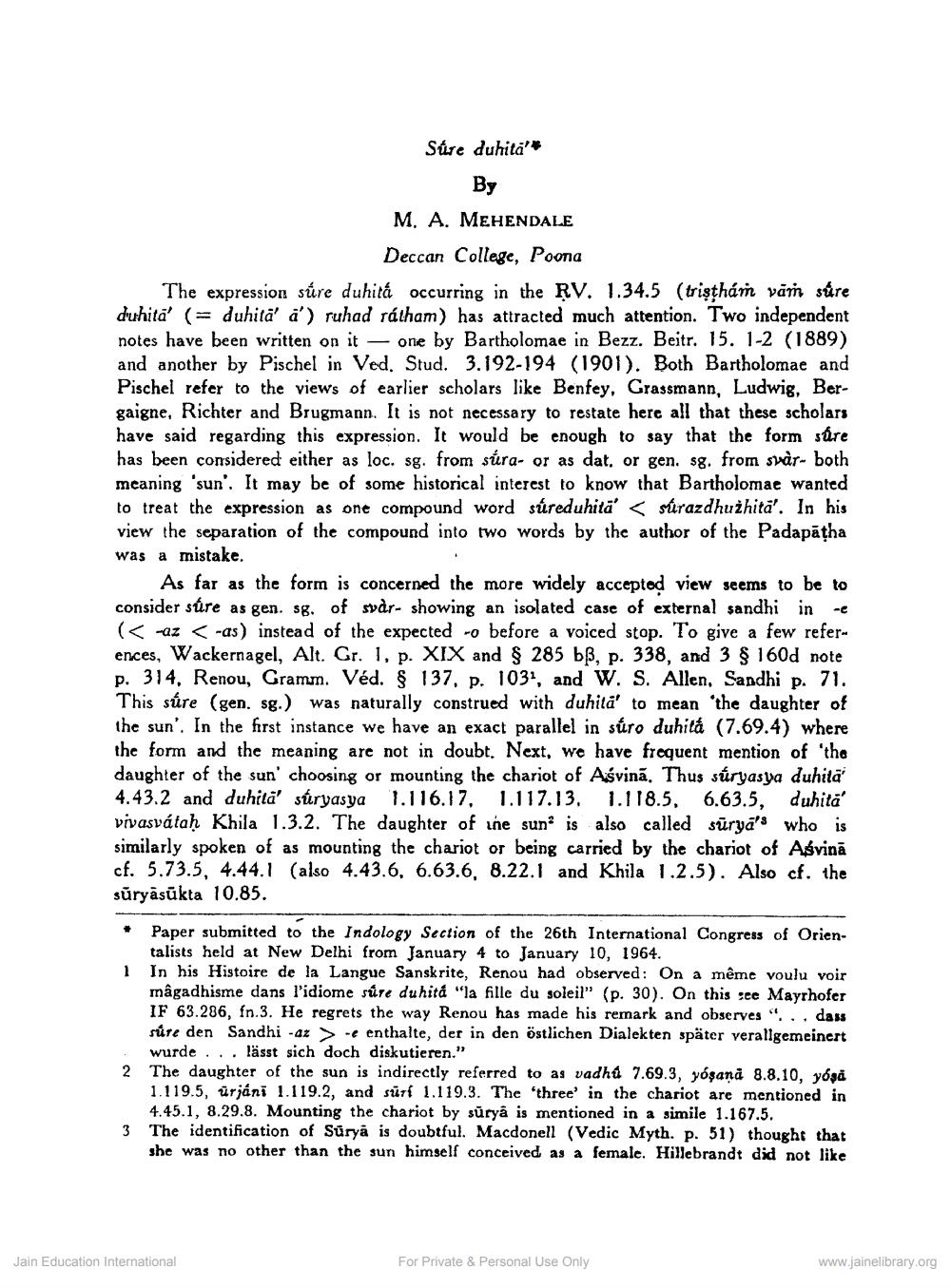________________
Súre duhita' - By M. A. MEHENDALE
Deccan College, Poona The expression súre duhitá occurring in the RV. 1.34.5 (tristhám vāí súre duhita' (= duhita' a') ruhad rátham) has attracted much attention. Two independent notes have been written on it - one by Bartholomae in Bezz. Beitr. 15. 1-2 (1889) and another by Pischel in Ved. Stud. 3.192-194 (1901). Both Bartholomae and Pischel refer to the views of earlier scholars like Benfey, Grassmann, Ludwig, Bergaigne, Richter and Brugmann. It is not necessary to restate here all that these scholars have said regarding this expression. It would be enough to say that the form süre has been considered either as loc. sg. from súra- or as dat, or gen. sg. from swar- both meaning 'sun'. It may be of some historical interest to know that Bartholomae wanted to treat the expression as one compound word súreduhita' < súrazdhużhita'. In his view the separation of the compound into two words by the author of the Padapātha was a mistake.
As far as the form is concerned the more widely acceptod view seems to be to consider súre as gen. sg. of svår- showing an isolated case of external sandhi in -e ( -az < -as) instead of the expected -before a voiced stop. To give a few references, Wackernagel, Alt. Gr. 1, p. XIX and § 285 bß, p. 338, and 3 $ 160d note p. 314. Renou, Gramm. Véd. § 137, p. 1031, and W. S. Allen, Sandhi p. 71. This súre (gen. sg.) was naturally construed with duhita' to mean 'the daughter of the sun'. In the first instance we have an exact parallel in súro duhitá (7.69.4) where the form and the meaning are not in doubt. Next, we have frequent mention of the daughter of the sun' choosing or mounting the chariot of Asvinā. Thus súryasya duhitä 4.43.2 and duhita' súryasya 1.116.17, 1.117.13. 1.118.5, 6.63.5, duhita' vivasvátah Khila 1.3.2. The daughter of the sun is also called sürya'S who is similarly spoken of as mounting the chariot or being carried by the chariot of Asvinā cf. 5.73.5, 4.44.1 (also 4.43.6, 6.63.6, 8.22.1 and Khila 1.2.5). Also cf. the súryāsūkta 10.85.
Paper submitted to the Indology Section of the 26th International Congress of Orientalists held at New Delhi from January 4 to January 10, 1964. In his Histoire de la Langue Sanskrite, Renou had observed: On a même voulu voir magadhisme dans l'idiome süre duhita "la fille du soleil" (p. 30). On this ree Mayrhofer IF 63.286, fn.3. He regrets the way Renou has made his remark and observes"., dass súre den Sandhi -az -enthalte, der in den östlichen Dialekten später verallgemeinert wurde ... lässt sich doch diskutieren." The daughter of the sun is indirectly referred to as vadhu 7.69.3, yoşana 8.8.10, yoga 1.119.5. ürjáni 1.119.2, and surf 1.119.3. The 'three' in the chariot are mentioned in 4.45.1, 8.29.8. Mounting the chariot by surya is mentioned in a simile 1.167.5. The identification of Surya is doubtful. Macdonell (Vedic Myth. p. 51) thought that she was no other than the sun himself conceived as a female. Hillebrandt did not like
2
Jain Education International
For Private & Personal Use Only
www.jainelibrary.org




